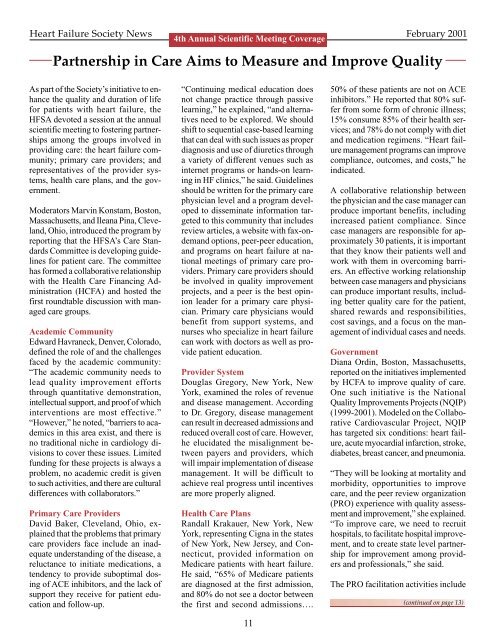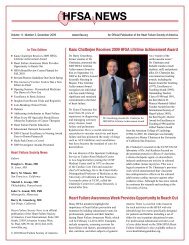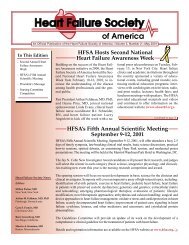Volume 3, Number 1 - Heart Failure Society of America
Volume 3, Number 1 - Heart Failure Society of America
Volume 3, Number 1 - Heart Failure Society of America
You also want an ePaper? Increase the reach of your titles
YUMPU automatically turns print PDFs into web optimized ePapers that Google loves.
<strong>Heart</strong> <strong>Failure</strong> <strong>Society</strong> News February 2001<br />
4th Annual Scientific Meeting Coverage<br />
Partnership in Care Aims to Measure and Improve Quality<br />
As part <strong>of</strong> the <strong>Society</strong>’s initiative to enhance<br />
the quality and duration <strong>of</strong> life<br />
for patients with heart failure, the<br />
HFSA devoted a session at the annual<br />
scientific meeting to fostering partnerships<br />
among the groups involved in<br />
providing care: the heart failure community;<br />
primary care providers; and<br />
representatives <strong>of</strong> the provider systems,<br />
health care plans, and the government.<br />
Moderators Marvin Konstam, Boston,<br />
Massachusetts, and Ileana Pina, Cleveland,<br />
Ohio, introduced the program by<br />
reporting that the HFSA’s Care Standards<br />
Committee is developing guidelines<br />
for patient care. The committee<br />
has formed a collaborative relationship<br />
with the Health Care Financing Administration<br />
(HCFA) and hosted the<br />
first roundtable discussion with managed<br />
care groups.<br />
Academic Community<br />
Edward Havraneck, Denver, Colorado,<br />
defined the role <strong>of</strong> and the challenges<br />
faced by the academic community:<br />
“The academic community needs to<br />
lead quality improvement efforts<br />
through quantitative demonstration,<br />
intellectual support, and pro<strong>of</strong> <strong>of</strong> which<br />
interventions are most effective.”<br />
“However,” he noted, “barriers to academics<br />
in this area exist, and there is<br />
no traditional niche in cardiology divisions<br />
to cover these issues. Limited<br />
funding for these projects is always a<br />
problem, no academic credit is given<br />
to such activities, and there are cultural<br />
differences with collaborators.”<br />
Primary Care Providers<br />
David Baker, Cleveland, Ohio, explained<br />
that the problems that primary<br />
care providers face include an inadequate<br />
understanding <strong>of</strong> the disease, a<br />
reluctance to initiate medications, a<br />
tendency to provide suboptimal dosing<br />
<strong>of</strong> ACE inhibitors, and the lack <strong>of</strong><br />
support they receive for patient education<br />
and follow-up.<br />
“Continuing medical education does<br />
not change practice through passive<br />
learning,” he explained, “and alternatives<br />
need to be explored. We should<br />
shift to sequential case-based learning<br />
that can deal with such issues as proper<br />
diagnosis and use <strong>of</strong> diuretics through<br />
a variety <strong>of</strong> different venues such as<br />
internet programs or hands-on learning<br />
in HF clinics,” he said. Guidelines<br />
should be written for the primary care<br />
physician level and a program developed<br />
to disseminate information targeted<br />
to this community that includes<br />
review articles, a website with fax-ondemand<br />
options, peer-peer education,<br />
and programs on heart failure at national<br />
meetings <strong>of</strong> primary care providers.<br />
Primary care providers should<br />
be involved in quality improvement<br />
projects, and a peer is the best opinion<br />
leader for a primary care physician.<br />
Primary care physicians would<br />
benefit from support systems, and<br />
nurses who specialize in heart failure<br />
can work with doctors as well as provide<br />
patient education.<br />
Provider System<br />
Douglas Gregory, New York, New<br />
York, examined the roles <strong>of</strong> revenue<br />
and disease management. According<br />
to Dr. Gregory, disease management<br />
can result in decreased admissions and<br />
reduced overall cost <strong>of</strong> care. However,<br />
he elucidated the misalignment between<br />
payers and providers, which<br />
will impair implementation <strong>of</strong> disease<br />
management. It will be difficult to<br />
achieve real progress until incentives<br />
are more properly aligned.<br />
Health Care Plans<br />
Randall Krakauer, New York, New<br />
York, representing Cigna in the states<br />
<strong>of</strong> New York, New Jersey, and Connecticut,<br />
provided information on<br />
Medicare patients with heart failure.<br />
He said, “65% <strong>of</strong> Medicare patients<br />
are diagnosed at the first admission,<br />
and 80% do not see a doctor between<br />
the first and second admissions….<br />
11<br />
50% <strong>of</strong> these patients are not on ACE<br />
inhibitors.” He reported that 80% suffer<br />
from some form <strong>of</strong> chronic illness;<br />
15% consume 85% <strong>of</strong> their health services;<br />
and 78% do not comply with diet<br />
and medication regimens. “<strong>Heart</strong> failure<br />
management programs can improve<br />
compliance, outcomes, and costs,” he<br />
indicated.<br />
A collaborative relationship between<br />
the physician and the case manager can<br />
produce important benefits, including<br />
increased patient compliance. Since<br />
case managers are responsible for approximately<br />
30 patients, it is important<br />
that they know their patients well and<br />
work with them in overcoming barriers.<br />
An effective working relationship<br />
between case managers and physicians<br />
can produce important results, including<br />
better quality care for the patient,<br />
shared rewards and responsibilities,<br />
cost savings, and a focus on the management<br />
<strong>of</strong> individual cases and needs.<br />
Government<br />
Diana Ordin, Boston, Massachusetts,<br />
reported on the initiatives implemented<br />
by HCFA to improve quality <strong>of</strong> care.<br />
One such initiative is the National<br />
Quality Improvements Projects (NQIP)<br />
(1999-2001). Modeled on the Collaborative<br />
Cardiovascular Project, NQIP<br />
has targeted six conditions: heart failure,<br />
acute myocardial infarction, stroke,<br />
diabetes, breast cancer, and pneumonia.<br />
“They will be looking at mortality and<br />
morbidity, opportunities to improve<br />
care, and the peer review organization<br />
(PRO) experience with quality assessment<br />
and improvement,” she explained.<br />
“To improve care, we need to recruit<br />
hospitals, to facilitate hospital improvement,<br />
and to create state level partnership<br />
for improvement among providers<br />
and pr<strong>of</strong>essionals,” she said.<br />
The PRO facilitation activities include<br />
(continued on page 13)
















